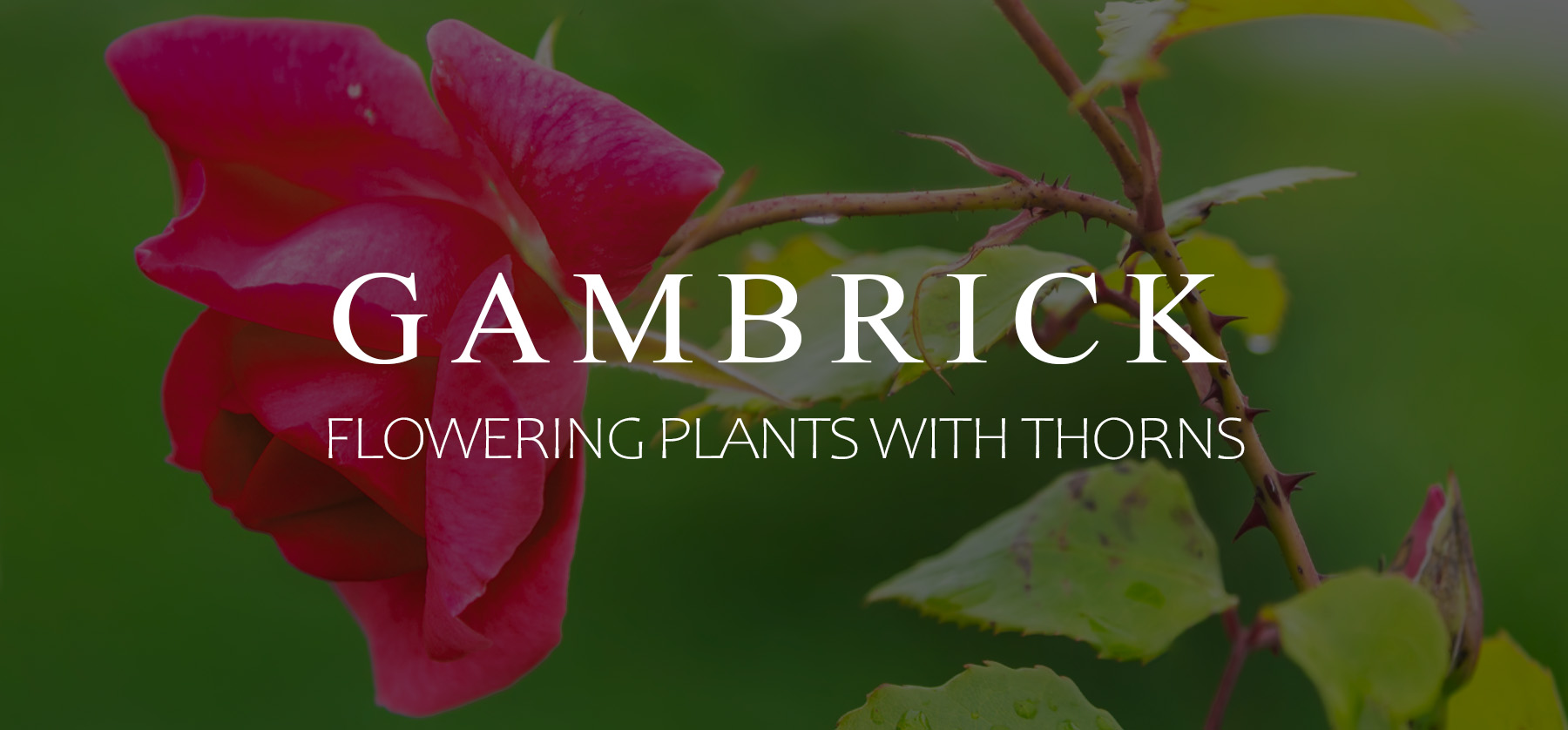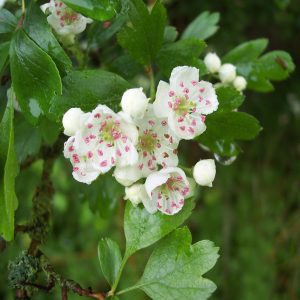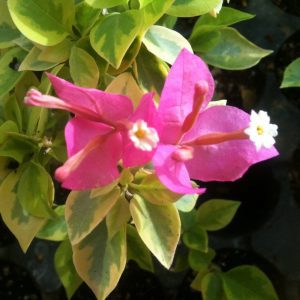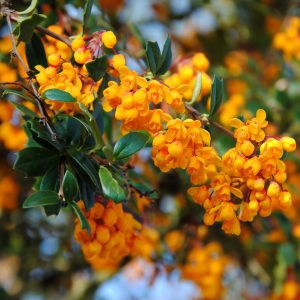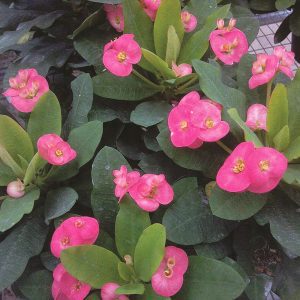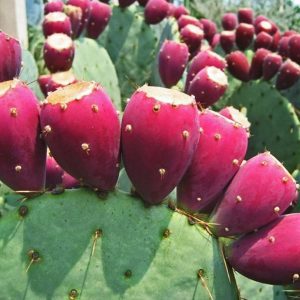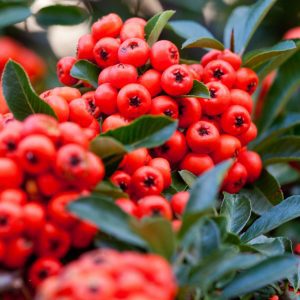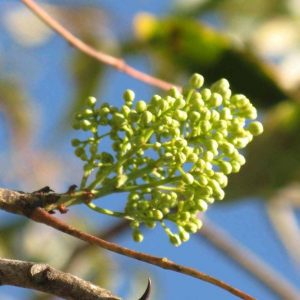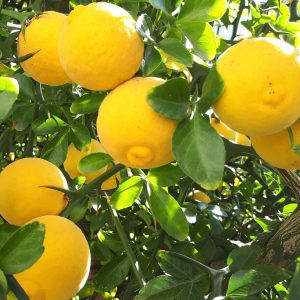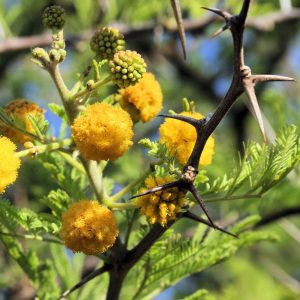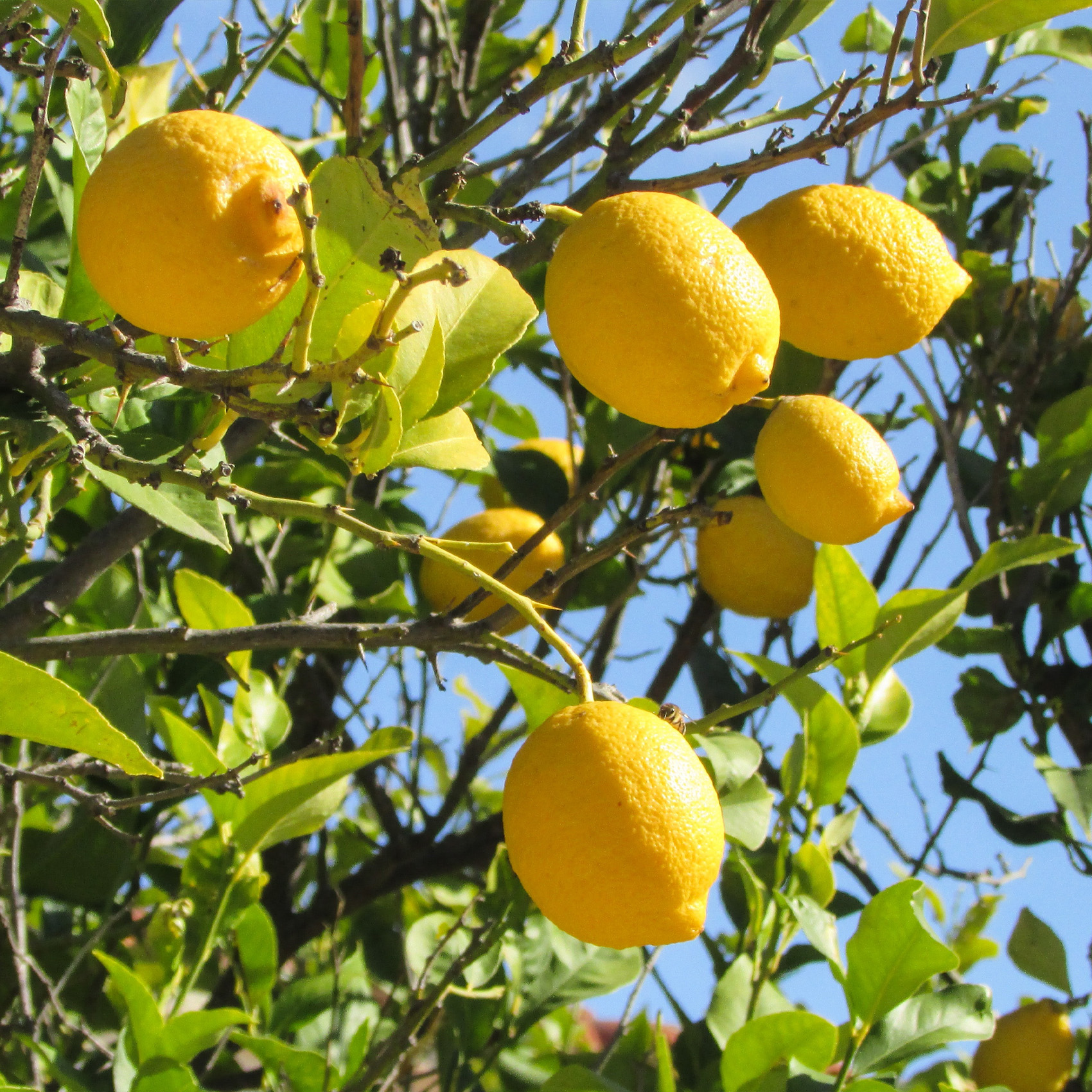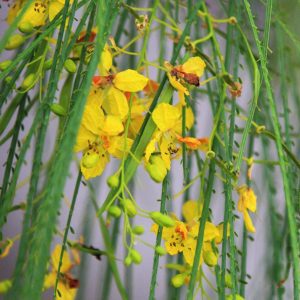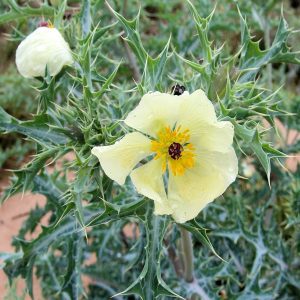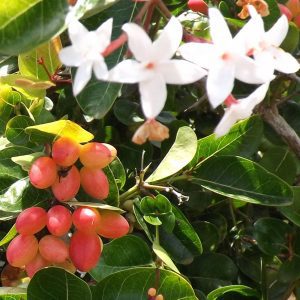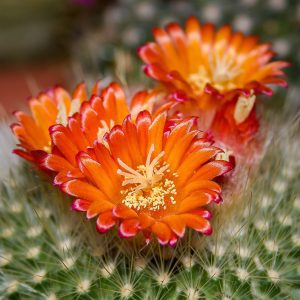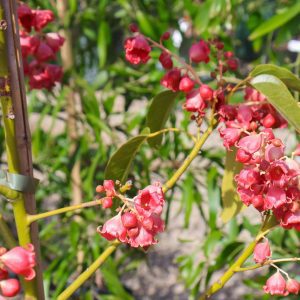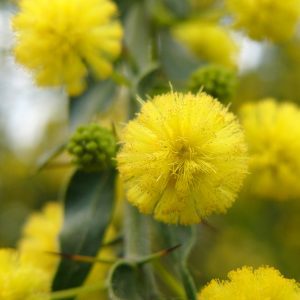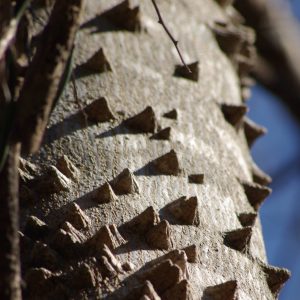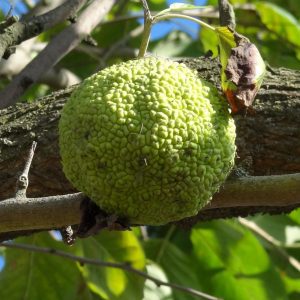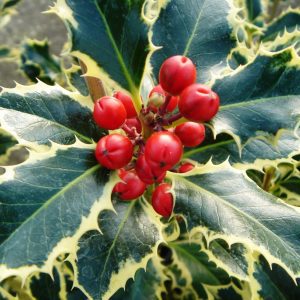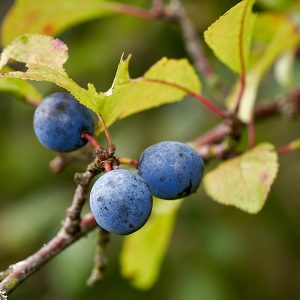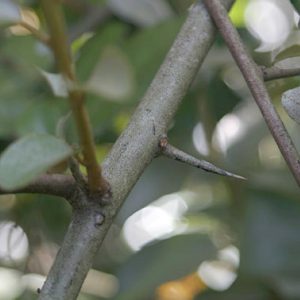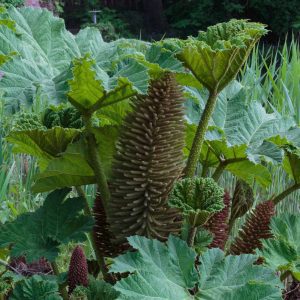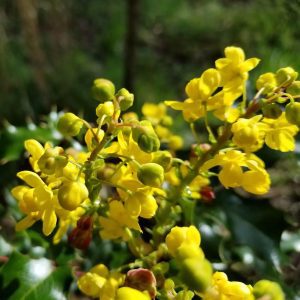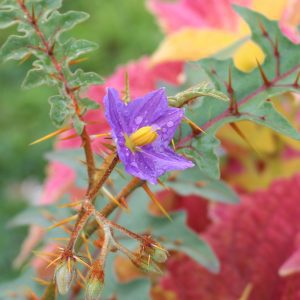31 Flowering Plants With Thorns
In botanical terms, “thorn” has a specific definition. Thorns are sharp, modified stems or branches that grow out directly from the plant’s main body. They’re usually hard and woody, serving a protective role for the plant against herbivores. But in casual usage, people often use “thorn” as a general term to describe any sharp structure on a plant. There are dozens of flowering plants with thorns, even though a thorn isn’t always technically a thorn.
Botanically, the structures refereed to as “thorns” are:
- Thorns: As mentioned, these are derived from shoots or branches, and are typically woody and robust. Examples can be found in plants like the honey locust tree.
- Spines: These are derived from leaves or parts of leaves, such as the leaf tip or stipules (small leaf-like appendages at the base of the leaf stalk). Cacti have spines, which are modified leaves.
- Prickles: These are derived from the plant’s outer layers or epidermis and can be found anywhere on the plant. They’re typically small and can be easily broken off, unlike thorns and spines. Roses are a classic example of plants with prickles.
These terms are often used interchangeably in non-scientific contexts despite their differences. However, knowing the correct terminology can be helpful in understanding how plants have adapted to their environments. They all serve similar purposes, but they develop from different parts of the plant’s anatomy.
31 Flowering Plants That Have Thorns
There are many beautiful flowering plants growing throughout the world that have thorns. They’re a defense mechanism that protects the plant from herbivores that would damage or eat the flowers. While thorny plants can add beauty and color to your landscape, they can also add a bit of extra security.
Flowing plants with thorns should be planted in areas where they won’t pose a hazard, especially to children and pets.
Remember, the term “thorn” is often used generically to refer to any sharp structure on a plant. But there are actually different terms (thorns, spines, prickles) depending on their botanical origins.
For the sake of this list, we’re including any flowering plant with a sharp, potentially harmful structure that may commonly be referred to as a “thorn”.
1. Roses (Genus Rosa)
Probably the most famous thorny, flowering plant, many species of roses are protected by thorns. Certainly, roses (Genus Rosa) are one of the most iconic groups of flowering plants, known for their vibrant colors, alluring fragrance, and cultural symbolism. A rose’s “thorns” are actually technically called “prickles,” since they are sharp outgrowths of the plant’s outer layer, or epidermis.
- Prickles serve as a defense against animals that might want to eat the plant or use it for nesting.
- The prickles are shaped in such a way that guides the animal’s mouth away from the plant, discouraging them from taking a bite.
- They make a rose bush less inviting for nesting birds and animals.
Despite being seen as a nuisance or even a danger by some gardeners, rose prickles have a beauty of their own. They often have a curved shape and can range in color from green to a deep red, almost black hue. Their presence adds to the diverse form and texture of the rose bush, adding another layer of interest to the plant.
Note: Not all roses have prickles. There are some species and cultivated varieties that are prickle-free, bred for their smooth stems. These are often favored in formal garden settings or in situations where prickles may pose a problem, such as in a garden often visited by children.
Prickles on rose stems can also help the plant attach itself to other structures, such as trellises or other plants, as it grows. This is particularly true of climbing rose varieties, which can use their prickles as makeshift hooks to support their upward growth.
While thorns may be a bit of a hazard when pruning or arranging roses, they serve important functions in the life of the plant, making it more resilient and adaptable to its environment.
2. Hawthorns (Genus Crataegus)
Hawthorns (Genus Crataegus) are a group of small flowering trees or shrubs that produce clusters of white or pink flowers in spring and have thorns along their branches. They’re widespread in temperate regions of North America, Europe, and Asia. You can recognize them by their beautiful white or pink blossoms in spring, followed by small apple-like fruits.
- Hawthorns possess true thorns, which are sharp, woody structures that grow out from the branches.
- Their thorns are an important defense mechanism against herbivores tempted by their leaves and fruits.
- In some species, these thorns can grow up to several inches.
- The thorns of some species of hawthorn have been used in traditional medicine. For example, they were once used in Europe to treat various ailments, including as a poultice for boils and sores.
The thorns of the hawthorn are typically stout and strong, making them a serious deterrent to any animal that tries to feed on the plant. This makes hawthorns ideal for creating hedgerows, barriers, or natural fences, as the dense growth and sharp thorns can help to keep out unwanted visitors.
Besides providing protection for the plant, thorns can also provide important shelter and nesting opportunities for birds, who can safely build their nests among the thorny branches, away from predators.
3. Bougainvillea (Genus Bougainvillea)
Known for its showy, colorful flowers, the Bougainvillea plant also has sharp thorns. Bougainvillea (Genus Bougainvillea) is a group of flowering plants native to South America, known for their vibrant and colorful blooms. Despite their delicate appearance, Bougainvillea plants are robust and resilient, often seen growing in warmer climates around the world.
- A notable feature of Bougainvillea is its thorns, which are technically known as spines in botanical terminology.
- These spines are thin, sharp, and located along the plant’s stems.
- Spines serve as a defensive measure, helping to protect the plant from herbivores.
- A Bougainvillea plants spines also help it climb by anchoring it to structures, trees, or other supports as it grows.
The contrast between the lush, vibrant flowers and sharp, formidable spines of the Bougainvillea plant is part of what makes this genus so unique. The spines are often hidden beneath the plant’s lush foliage, making it a bit of a surprise for the unaware, especially during pruning or handling the plant.
Despite their somewhat prickly nature, Bougainvillea plants are popular for their aesthetic appeal. Their striking, colorful blooms make them an excellent choice for ornamental gardening. They’re commonly used in landscapes as hedges, on trellises, or in hanging baskets.
4. Blackberry and Raspberry (Genus Rubus)
Blackberry and Raspberry plants (Genus Rubus) are well-known fruit-bearing plants found in many parts of the world. They’re famous for their sweet, juicy fruits, but they’re equally notable for their thorny stems. The “thorns” on Rubus plants are technically known as prickles. These sharp structures arise from the plant’s outer layer or epidermis and can be found along the stems and underside of the leaves. They act as a defense mechanism to deter animals from eating the plants or their delicious fruits.
- These prickles can be quite sharp and may cause discomfort or even injury when the plants are handled without care.
- It’s easy to accidentally prick oneself on the thorns when harvesting the fruits.
- Some modern cultivars of raspberries and blackberries have been bred to be “thornless,” making them easier and safer to handle.
Despite the prickly challenge they can pose, thorns don’t overshadow the appeal of these plants. The value of their fruit, both for direct consumption and for use in jellies, jams, pies, and other culinary preparations, far outweighs the inconvenience of their thorns.
5. Barberry (Genus Berberis)
This thorny shrub bears small yellow flowers in spring, followed by red or blue berries. Barberry (Genus Berberis) is a group of about 500 species of deciduous and evergreen shrubs from 1–5 m tall with thorny shoots. They’re native to temperate and subtropical regions of Europe, Asia, Africa, North America, and South America.
The plants are characterized by their small, yellow flowers that bloom in spring, followed by red or blue berries. However, another distinct feature of Barberry shrubs is their thorns. These thorns, which are technically spines, are modified leaves and grow in groups of two or three along the length of the stem.
- The thorns serve as a protective mechanism for the plant, deterring herbivores from feeding on its leaves and berries.
- A Barbey plant’s thorns are sharp and robust, providing a formidable barrier to any potential threats.
- Because of their thorny nature, Barberry shrubs are often used in hedges as they create an impenetrable barrier.
Beyond their protective function, the thorns also play a role in the plant’s aesthetic appeal. They add texture and interest to the plant, and some species have thorns that turn a reddish color in the fall, contributing to the shrub’s autumn display.
6. Crown of Thorns (Euphorbia milii)
The Crown of Thorns, or Euphorbia milii, is a succulent plant native to Madagascar. It’s an intriguing plant known for its small but vibrant flowers and densely spiny stems. The thorns on a Crown of Thorns plant are technically spines, modified parts of the leaf or leaf structures. These spines are quite substantial and sharp, serving as a defense mechanism against herbivores. They give the plant its common name due to their resemblance to the biblical crown of thorns.
- The plant’s spines are arranged in pairs along the length of the plant’s stems, providing an interesting visual contrast to the small, brightly colored flowers that the plant produces.
- The flowers, or more accurately, bracts (modified leaves), come in a variety of colors, most commonly red or pink, and can bloom throughout the year under optimal conditions.
- The Crown of Thorns plant is drought-tolerant and can thrive in harsh conditions, thanks to its succulent nature.
- It’s often used as a houseplant or in xeriscaping (landscaping and gardening that reduces or eliminates the need for supplemental water), where its unusual, somewhat stark appearance and vivid flowers make it stand out.
Despite its intimidating appearance, the Crown of Thorns is a relatively easy plant to care for, making it a popular choice for many gardeners. Its unique combination of succulent and flowering plant characteristics, coupled with its iconic thorny stems, makes it a fascinating plant to grow and observe.
7. Prickly Pear Cactus (Genus Opuntia)
These cacti have large, paddle-like segments covered in small, barbed thorns and bear colorful, cup-shaped flowers. Prickly Pear Cactus, belonging to the Genus Opuntia, is a unique group of cacti known for their paddle-shaped segments, vibrant blooms, and the edible fruit they produce. They’re native to the Americas but have been introduced to other parts of the world due to their adaptability and resilience.
The “thorns” of Prickly Pear Cactus are actually referred to as spines in botanical terms. These spines are modified leaves, developed to protect the cactus from animals looking for water in arid environments. They’re typically hard, sharp, and densely packed, and can vary greatly in size and color, depending on the species.
- One unique feature of Opuntia spines is that they often come with smaller, hair-like spines known as glochids.
- Glochids can detach easily upon touch and are often more irritating than the larger, more visible spines.
Despite their prickly nature, Opuntia cacti are valuable plants both ecologically and agriculturally. Their fruits, known as prickly pears, are edible and are a staple in many Latin American cuisines. They’re also used to make candies, jellies, and beverages.
8. Pyracantha (Genus Pyracantha)
Pyracantha, commonly known as Firethorn, is a genus of thorny, evergreen shrubs native to an area extending from Southwest Europe east to Southeast Asia. They’re well-known for their vibrant, berry-like pomes, which can be orange or red, and for their small white flowers that bloom in the spring.
The thorns of Pyracantha are robust, sharp, and grow along its branches. They serve as a defensive mechanism, protecting the plant from animals that might want to feed on its attractive fruits or leaves. They can be quite substantial and provide an effective deterrent to herbivores, making Pyracantha a good choice for boundary hedging or as a barrier plant.
- Despite their sharp thorns, Pyracantha shrubs are valued for their ornamental qualities.
- The plants produce clusters of small, white flowers in the spring, followed by bright, colorful fruits in the autumn that can persist into the winter, providing a long season of interest.
- The fruits are an important food source for birds during winter months when other foods may be scarce.
Pyracantha are a hardy plant that thrives in a range of conditions. It has beautiful flowers and defensive thorns that protect it from herbivores. They’re great for local wildlife with flowers that attract pollinating insects. Their dense thorny growth is ideal for nesting birds which also eat the berries.
9. Hercules’ Club (Zanthoxylum clava-herculis)
Hercules’ Club, also known as Zanthoxylum clava-herculis, is a small to medium-sized tree native to the Southeastern United States. It’s a part of the Rutaceae family, which also includes citrus plants. It is often recognized for its distinctive, spiky bark and its clusters of tiny flowers.
One of the key features of Hercules’ Club is its thorns. These thorns are numerous, prominent, and cover the bark of the tree, giving it a very unique and somewhat formidable appearance.
- It produces small, greenish-white flowers in the spring, which are attractive to pollinators.
- By fall, these flowers turn into small, dark fruit that is enjoyed by various bird species.
- The leaves of the tree, when crushed, give off a citrus-like aroma, owing to its membership in the Rutaceae family.
- The tree is also known as the “toothache tree” for the numbing sensation its bark can cause.
- Hercules’ Club has thorny branches and small flowers.
The thorns grow in a pyramid-like cluster, creating a “club” shape, hence the common name Hercules’ Club. They serve as a protective mechanism, deterring herbivores from eating the leaves or bark of the tree.
10. Trifoliate Orange (Poncirus trifoliata)
Trifoliate Orange (Poncirus trifoliata), also known as the Chinese bitter orange or hardy orange, is a small deciduous tree or large shrub native to northern China and Korea. It’s unique for being one of the few citrus plants that can withstand cold climates, making it a popular choice for grafting other citrus plants onto a more winter-hardy rootstock.
One of the defining features of the Trifoliate Orange is its thorns. They’re sturdy and sharp, growing directly on the branches, and serve as a defense mechanism, against potential herbivores interested in its leaves or fruit.
- The thorns, along with the dense growth habit of the Trifoliate Orange, make it a suitable choice for a barrier or hedge in landscapes.
- Care should be taken when handling or pruning the plant to avoid injury.
- This deciduous shrub or small tree is covered with sharp thorns and produces white flowers in spring.
Trifoliate Orange plants bear small, white, fragrant flowers in spring, followed by green fruits that mature to a bright yellow in the fall. The fruits are technically edible but are extremely bitter, lending to the name bitter orange. Despite their taste, the fruits are often used in marmalades and as a flavoring in liqueurs.
11. Acacia (Genus Acacia)
Certain species of acacia trees have thorns and produce spherical, yellow or white flowers. Acacia is a large and diverse genus of flowering plants within the family Fabaceae. The family consists of shrubs and trees native to tropical and subtropical regions, particularly Australia and Africa. They’re known for their distinctive, feather-like leaves, bright yellow or white spherical flowers, and their thorns.
The thorns on Acacia trees serve as a defensive mechanism against herbivores. Depending on the species, these thorns can be either straight or hooked and are usually located at the base of the leaf stalks. Some African species of Acacia, such as the Whistling Thorn (Acacia drepanolobium), have particularly large thorns, which can reach lengths of up to 3 inches.
- The presence and structure of thorns in Acacia species is an interesting aspect of their ecology.
- In the African savannah, some species of Acacia have a mutualistic relationship with ants, which live in the thorns and protect the tree from herbivores.
Acacia trees have beautiful bright yellow or white flowers that are often fragrant, attracting various pollinators. Many species of Acacia produce gum or resin that’s been used for food, medicine, and to make high-quality ink.
12. Lemon and Other Citrus Trees (Genus Citrus)
Citrus trees, part of the genus Citrus, are evergreen trees and shrubs native to Asia, renowned for their fragrant flowers and flavorful fruit. This genus includes well-known species such as lemons, oranges, grapefruits, limes, and tangerines, which are widely cultivated in warm climates around the world for their edible fruit.
- Despite their thorns, citrus trees are loved for their fruit and other attractive features.
- The trees bear beautiful, white, fragrant flowers that can bloom and produce fruit throughout the year in suitable climates.
- The fruit, besides being edible and highly nutritious, also adds color and interest to the landscape.
- Citrus trees are also known for their aromatic oils, found in the leaves, peel, and flowers, used in everything from cooking to cleaning products to perfumes.
Many Citrus species and cultivars, including many lemon trees, possess thorns. They’re typically found on the branches and are pretty sharp. Their primary function is to protect the tree from herbivores interested in feeding on the leaves or fruit. However, not all citrus trees have thorns, and some have been specifically bred to be thornless to make picking fruit easier.
13. Jujube (Ziziphus jujuba)
Jujube (Ziziphus jujuba), also known as Chinese date or red date, is a species of small deciduous tree in the family Rhamnaceae, native to South Asia and China. It’s widely cultivated for its sweet and tart fruit, which can be eaten fresh or dried. The Jujube tree is very hardy, tolerant of drought and high temperatures, making it a good choice for regions with challenging climates.
- Apart from its thorns, Jujube has many attractive features.
- It produces small, fragrant flowers that attract pollinators.
- The fruit is small and round, turning from green to red or purplish-black as it matures.
- The fruit is not only delicious but also rich in vitamin C and other nutrients.
- This is a thorny fruit tree that produces small, fragrant yellow-green flowers.
One of the key features of the Jujube tree is its thorns. These thorns, often found in pairs, are short and sharp, located on smaller branches and twigs. They serve as a protective mechanism for the plant against herbivores that might be interested in its leaves or fruits. The presence of thorns necessitates careful handling when harvesting the fruit or pruning the tree.
14. Jerusalem Thorn (Parkinsonia aculeata)
Jerusalem Thorn (Parkinsonia aculeata), also known as Mexican Palo Verde or Retama, is a small deciduous tree or large shrub native to the southwestern United States, Mexico, and the Caribbean. It’s known for its distinctive, bright green bark, tiny leaves, and delicate yellow flowers. The plant is well-suited to arid environments, displaying notable drought tolerance.
One of the key features of the Jerusalem Thorn is its thorns. These thorns, which can be quite sharp, are located at the base of the leaves along the branches. They serve as a protective mechanism against herbivores that might be tempted to eat its foliage or flowers. Care should be taken when handling or pruning the tree to avoid injury from these thorns.
- The Jerusalem Thorn has bright green bark and tiny leaves that give it a feathery appearance.
- In spring and intermittently throughout the year, it produces clusters of bright yellow flowers.
- This plant is a small tree or large shrub with long, green, photosynthetic branches and thorns.
The Jerusalem Thorn is also appreciated for its environmental tolerance. It can withstand high temperatures, poor soil, and prolonged dry periods, making it an excellent choice for low-water landscapes.
15. Mexican Poppy (Argemone mexicana)
Mexican Poppy (Argemone mexicana), also known as Mexican prickly poppy or thistle poppy, is an annual herbaceous plant native to Mexico and the southwestern United States. It belongs to the poppy family, Papaveraceae, and is known for its bright yellow flowers and spiny, thistle-like appearance.
One of the key features of the Mexican Poppy is its thorns. The entire plant, including the stems, leaves, and seed pods, is covered in sharp spines or prickles. These serve as a protective mechanism against herbivores that would eat its foliage or flowers. Due to these thorns, care must be taken when handling or removing the plants to avoid injury.
- Despite its prickly nature, the Mexican Poppy has considerable ornamental appeal.
- It produces large, bright yellow flowers that resemble those of other poppy species.
- The spiny, silver-green foliage also offers visual interest and textural contrast.
- This is an annual herb with yellow flowers and sharp thorns on the stems and leaves.
All parts of the Mexican Poppy are toxic if ingested, and it can become invasive in some areas due to its prolific seed production. It’s a hardy plant that’s often found in disturbed soils and is quite drought-tolerant.
16. Natal Plum (Carissa macrocarpa)
Natal Plum (Carissa macrocarpa) is a small, evergreen shrub native to South Africa. It’s grown for its glossy, dark green leaves, fragrant white flowers, and distinctive, plum-like fruits. This plant is often used as a hedge or ornamental shrub in warmer climates due to its attractive appearance and resilience to coastal conditions.
A notable feature of the Natal Plum is its thorns. These are sharp and often forked, growing along the plant’s branches. They serve as a deterrent to herbivores that might otherwise feed on the plant’s leaves and fruits. Due to these thorns, caution is required when pruning or otherwise handling the plant.
- Despite its thorns, the Natal Plum has significant ornamental and culinary appeal.
- It blooms with star-shaped, white, and highly fragrant flowers throughout much of the year.
- The flowers are followed by bright red, plum-like fruits that are attractive and edible once fully ripe.
- The plums have a unique, slightly tart flavor and can be used in jams, jellies, pies, or eaten fresh.
- This dense, spiny shrub produces beautiful, fragrant, star-shaped white flowers.
The Natal Plum is quite hardy and tolerant of poor soils and salt spray, making it an excellent choice for coastal areas.
17. Flowering Cacti (Cactaceae family)
While we’ve mentioned the Prickly Pear Cactus, many other cacti species also bear thorns and produce flowers, including the Saguaro, Barrel Cactus, and Christmas Cactus. Cacti, belonging to the Cactaceae family, are a diverse group of plants primarily native to the Americas. They’re well-known for their ability to thrive in arid environments due to their specialized adaptations, such as succulent stems, reduced leaves, and the presence of spines or thorns.
The “thorns” of cacti are technically modified leaves that have evolved into sharp spines. These spines serve multiple purposes: they deter herbivores, shade the cactus from the sun to reduce water loss, and in some species, direct rainwater towards the base of the plant. Depending on the cactus species, these spines can be long and needle-like, short and bristly, or even feather-like.
- Cacti produce a variety of beautiful, often large and vibrant flowers.
- Depending on the species, these flowers may last for months or only for a single day.
- The flowers are usually pollinated by insects, birds, and bats.
- Following pollination, many cacti produce fleshy, brightly colored fruits.
Cacti vary widely in size and shape. Some are small and round, others tall and columnar, and some even take on a flattened, leaf-like appearance. Their forms and growth habits make them a popular choice for rock gardens, desert landscaping, indoor houseplants, and other low-water gardening situations.
18. Flame Tree (Brachychiton acerifolius)
Native to Australia, this tree produces clusters of bright red flowers. Its seed pods have a curved, pointed shape, and its trunk and branches can bear sharp thorns. The Flame Tree (Brachychiton acerifolius), also known as the Illawarra Flame Tree, is an iconic Australian native tree that’s well-regarded for its brilliant display of vibrant red flowers, which give the tree its name. This display often coincides with the tree shedding its leaves, further enhancing the visual impact of the flowering period.
While the Flame Tree is predominantly known for its showy flowers, it also possesses thorns or spiky protuberances, especially on younger plants. Its thorns are modified leaf stipules and are generally not as sharp or dangerous as thorns on some other plant species. Over time, as the tree matures, the prominence of these thorns tends to reduce.
- One of the most remarkable features of the Flame Tree, aside from its stunning floral display, is the distinctive seed pod.
- The pods are large, woody, boat-shaped, and filled with yellow, hairy seeds.
- While these seeds can be a bit messy when they fall, they add to the overall uniqueness of the tree.
The Flame Tree is quite adaptable and can grow in various soil types, provided they are well-drained. It’s also drought-tolerant once established, making it a popular choice for urban landscapes and low-water-use gardens.
19. Kangaroo Thorn (Acacia paradoxa)
Native to Australia, this plant gets its name from its spine-tipped phyllodes and sharp thorns. Kangaroo Thorn (Acacia paradoxa), also known as Paradox Acacia, is a dense shrub native to Australia. It’s widely recognized for its defensive adaptations, including a heavy coverage of sharp, hooked thorns, which have earned it the name Kangaroo Thorn.
The thorns are a significant deterrent against browsing by animals. They appear in pairs at the base of the phyllodes (modified leaf stalks that act as leaves) and can make handling the plant challenging without proper protection.
- Despite its prickly nature, Kangaroo Thorn is valued for its bright yellow, spherical flower clusters that bloom from late winter to spring.
- The flowers are not only a visual delight but also serve as a nectar source for pollinators.
- Kangaroo Thorn is a hardy plant that grows in a variety of soils and climates.
- It can withstand drought, frost, and poor soil conditions, making it a robust choice for challenging sites.
- The plant has been used for erosion control and as a security hedge, thanks to its dense growth and sharp thorns.
However, outside its native range, Kangaroo Thorn has been known to become invasive, and care should be taken to prevent it from spreading uncontrollably.
20. Floss Silk Tree (Ceiba speciosa)
A distinctive tree native to South America, it has a trunk studded with large thorns and beautiful pink flowers. Floss Silk Tree (Ceiba speciosa), also known as the Chorisia speciosa, is a striking deciduous tree native to the tropical and subtropical forests of South America. It is well-known for its beautiful flowers and distinctive, thorny trunk.
The trunk of the Floss Silk Tree is a sight to behold: thick, bottle-shaped, and covered in a pattern of large, conical thorns. These thorns are not merely decorative; they help to protect the tree from animal predation. As the tree matures, the thorns tend to reduce, giving the bark a smoother appearance.
- The tree gets its name from its gorgeous flowers.
- These flowers bloom in the cooler months, showcasing large, five-petaled blossoms that are pink with a creamy center.
- Following the flowers, the tree produces large, elongated fruits.
- When these fruits split open, they reveal a mass of white, fluffy fibers – the “floss silk” for which the tree is named.
The Floss Silk Tree is a hardy plant, able to tolerate dry conditions and poor soils. However, it thrives best in well-drained soils and sunny conditions. Given its ultimate size – up to 60 feet tall – and thorny trunk, this tree needs space and should be placed thoughtfully in the landscape.
21. Osage Orange (Maclura pomifera)
This North American tree has sharp thorns and small, greenish flowers. Osage Orange (Maclura pomifera), also known as hedge apple, horse apple, or bodark, is a deciduous tree native to the South-Central United States. It’s known for its large, bumpy green fruit, as well as its durable and rot-resistant wood. It’s been used historically for various purposes including making bows and fence posts.
A key feature of the Osage Orange tree is its thorns. The thorns are typically located on the branches and young twigs and can be quite large. They serve as a defense mechanism, deterring animals from eating the tree’s leaves or fruit.
- An osage orange plant’s thorns are sharp and stout, providing an effective deterrent to potential threats.
- Large thorns and dense foliage have made the Osage Orange a popular choice for hedging.
- The thorny, impenetrable hedge acts as a living fence, effectively keeping livestock in and potential predators out. This use earned it the nickname “hedge apple.”
Despite its thorns, the tree looks nice and can be used as a hedge. It produces small, inconspicuous flowers in spring, followed by its signature large, bumpy fruit in the fall. Although the fruit is generally inedible to humans, it’s sometimes used to make decorative arrangements.
22. Durian (Durio zibethinus)
Durian (Durio zibethinus) is a tropical fruit tree native to Southeast Asia, particularly Malaysia, Indonesia, and Thailand. The tree is best known for its distinctive fruit, both for its size and the strong aroma it produces when ripe. This fruit tree has sharp thorns on its outer shell and produces small, inconspicuous flowers.
The exterior of the durian fruit is covered in hard, sharp spikes, which serve as a form of protection. While not technically classified as thorns, these spikes provide a similar function by deterring animals from eating the fruit. However, some larger animals, such as elephants, can still manage to handle the fruit despite its intimidating exterior.
- The spikes on the durian are formidable and can cause injury if the fruit is not handled carefully.
- Because of its spikes, care must be taken when harvesting or transporting durian.
Inside the spiky shell, the fruit’s flesh is soft, custard-like, and extremely flavorful, earning it the nickname “king of fruits” in some parts of the world. However, the smell of the ripe fruit is notoriously strong and divisive, leading to its banishment from some public places in Southeast Asia, including hotels and public transportation.
23. Holly (Genus Ilex)
Holly (Genus Ilex) is a large genus that includes about 480 species of flowering plants in the family Aquifoliaceae. They can range from small shrubs to large trees and are native to all continents except Antarctica. They’re well-known for their bright red berries and glossy, evergreen leaves.
A distinguishing feature of many holly species is their spiny leaves. These leaves are often glossy and dark green with edges lined with sharp, pointed “teeth” or spines. Although they’re not “thorns” in the botanical sense, they serve a similar purpose as a defense mechanism. They help deter herbivores from feeding on the plant by providing a sharp deterrent.
- The spiny leaves of holly plants are an iconic part of their appeal, particularly species like the English holly (Ilex aquifolium), which is often used in Christmas decorations.
- The contrast between the rich green leaves, sharp spines, and bright red berries provides a striking and festive color contrast.
The resilience of holly plants, along with their attractive features and protective spiny leaves makes them popular in various landscaping scenarios. They can be used as border plants, barriers, or focal points in a garden due to their unique appearance and hardiness.
24. Blackthorn (Prunus Spinosa)
The Blackthorn (Prunus Spinosa), commonly known as Sloe, is a deciduous shrub recognized for its widespread use in hedges due to its dense growth and sharp, formidable thorns. Native to Europe, western Asia, and northwest Africa, this species is part of the Rosaceae family.
A key characteristic of the Blackthorn is its thorns. The shrub is covered with long, stiff, sharp thorns that measure up to two inches. These thorns are robust and can create an impenetrable barrier, thus making Blackthorn an excellent choice for livestock-proof hedging or a protective habitat for wildlife. The thorns grow directly from the stems, are dark in color, and are exceptionally hardy. Their strength and sharpness mean they can even puncture car tires, underlining their protective nature.
- During the winter season, the thorns are especially noticeable as the leaves drop away, but the thorns remain, giving the plant its name Blackthorn.
- The thorns, coupled with the plant’s ability to regenerate from the base when cut back, make it an enduring presence in many landscapes.
- Its capacity to withstand harsh weather and poor soils is a testament to its hardiness.
In folklore, the Blackthorn’s thorns have been associated with protection and warding off evil. The wood, dense and black, is used in the making of walking sticks and was traditionally used to make the Irish shillelagh, a cudgel or walking stick equipped with a large, knobbly end, often capped with metal.
While the Blackthorn is known for its beautiful spring blossom and blue-black fall berries, the thorns are integral to the plant’s identity, contributing significantly to its survival, usage, and folklore.
25. Californian Fuchsia (Epilobium canum)
The California Fuchsia (Epilobium canum), also known as Zauschneria or Hummingbird Trumpet, is a low-growing, semi-evergreen perennial sub-shrub native to western North America. It typically has three long thorns on every stem node which helps protect it from herbivores and other animals that would disturb its flowers. Its flowers are narrowly lance-shaped, gray-green leaves that are velvety to the touch and produce enough nectar for hummingbirds to start their southward migration.
- Can be planted as a hedge row.
- Requires very little maintenance.
- Survives in just about any soil.
- Thrives in full sun in well-drained soils.
- Sandy or gritty soils are much better than heavy clay soils.
- Drought-tolerant once well-established.
- Virtually pest and disease free.
Californian Fuchsia is drought-tolerant and remains evergreen throughout the year. Once pollinated, its flowers produce pods that contain seeds. The pods split and release seeds that have a feather-like design for easy wind dispersal.
Native to the southwestern states in the US, it’s a great plant for rock and gravel gardens or raised beds.
26. Silverthorn (Elaeagnus pungens)
The Silverthorn (Elaeagnus pungens), also commonly known as Thorny Elaeagnus or Thorny Olive, is an evergreen shrub that hails from the family Elaeagnaceae and is native to Japan and China. It’s a durable and versatile plant, known for its resilience and adaptability to various conditions, including coastal environments, drought, and poor soils.
One of the most distinctive features of the Silverthorn is its thorns. The plant’s common name “Thorny Elaeagnus” is a nod to this attribute. These thorns emerge from the plant’s stems, providing a robust defense mechanism against herbivores and making it a deterrent for human traffic when planted as a hedge. The thorns are sharp, stiff and are generally hidden by the plant’s dense, lustrous foliage, which adds an element of surprise for those unaware of their presence.
- The thorns not only provide a means of protection but also serve a climbing support function.
- The Silverthorn can grow up to 12 to 15 feet high and spread up to 15 to 20 feet wide.
- Its thorny nature and vigorous growth habit make it an ideal plant for creating impenetrable hedges, screens, or windbreaks.
- Due to its aggressive growth and prolific seed production, the Silverthorn has been considered invasive in some areas. It’s always recommended to check local guidelines before planting.
In addition to its thorns, the Silverthorn is also noted for its silvery-green leaves, fragrant flowers, and small edible fruits. Its flowers have a sweet, strong fragrance that can be a delightful addition to the fall and winter landscape when few other plants are in bloom.
27. Giant Rhubarb (Gunnera manicata)
The Giant Rhubarb (Gunnera manicata), also known as Dinosaur Food, is a species of flowering plant in the family Gunneraceae. Despite its common name, it is not related to the edible rhubarb (Rheum rhabarbarum) but is so-called due to the resemblance of their large, rhubarb-like leaves. Native to the Serra do Mar mountains of southeastern Brazil, this plant is known for its large, dramatic foliage and unique structure.
A prominent feature of the Giant Rhubarb is the presence of spiky, thorn-like protrusions on its stems and underside of the leaves. These are not true thorns but are rather prickles, similar to what you might find on a rose bush. They range in color from reddish-brown to green, depending on the maturity of the plant and the specific location of the prickle.
- The prickles are quite sharp and can cause discomfort if handled without care, so when planting or maintaining this plant, it’s advisable to wear sturdy gloves.
- These prickles serve as a defense mechanism against herbivores which may be deterred from eating the plant due to the potential discomfort.
- The prickles, combined with the plant’s substantial size – mature leaves can reach up to 10 feet in diameter, and the plant itself can reach a height of up to 8 feet – give the Giant Rhubarb a prehistoric, somewhat alien appearance, earning it the nickname “Dinosaur Food.”
Aside from its prickles, Gunnera manicata is recognized for its large, umbrella-like leaves and small, reddish-green flowers that grow on erect spikes. It prefers damp conditions and can often be found near ponds or streams in garden settings.
28. Honey Locust (Gleditsia)
The Honey Locust (Gleditsia triacanthos), a Fabaceae (legume) family member, is a deciduous tree native to central North America. Notable for its adaptability and resilience, it can thrive in various soils and weather conditions, making it a popular choice in urban landscapes.
One of the defining features of the Honey Locust is its large, menacing thorns. These thorns are branched and can reach lengths of up to 30 cm (12 inches). They typically grow in clusters on the trunk and branches, providing a strong deterrent against herbivores. These thorns are so robust that they’ve been used as nails.
- The Honey Locust’s thorns are modified branches and emerge directly from the tree’s bark.
- They are most common on younger trees or the sprouts that grow from the base of mature trees.
- As the tree ages, the thorns tend to become less prevalent.
- It’s important to note that there are also thornless varieties of the Honey Locust.
- These have been developed for ornamental use to provide the benefits of the tree without the hazards of its thorns.
- These cultivars, like the ‘Shademaster’ and ‘Sunburst’, are commonly used in landscaping due to their fast growth, ability to provide filtered shade, and beautiful fern-like foliage.
Aside from its thorns, the Honey Locust is known for its sweet, legume-like pods that give the tree its common name. These pods were used by Native Americans and early settlers as a food source and are also consumed by various wildlife species.
29. Ocotillo (Fouquieria splendens)
The Ocotillo (Fouquieria splendens), also known as Coachwhip, Candlewood, or Jacob’s Staff, is a unique plant native to the deserts of the Southwestern United States and Northern Mexico. This plant is part of the Fouquieriaceae family, characterized by its long, slender, and spiny cane-like unbranched stems.
Ocotillo’s most notable feature is its thorns. The plant has numerous thorny stems that can grow up to 20 feet tall. These stems are covered with sharp, robust thorns reaching up to two inches long. The thorns help to protect the plant from herbivores and provide a distinctive aesthetic appeal. They’re arranged along the stems in pairs and can be pretty sharp. Thus, it is advisable to handle Ocotillo with care.
- These long, whip-like, spiny branches are mostly leafless but will sprout small, green leaves within 48 hours of significant rainfall.
- This quick response to rain makes the Ocotillo a drought-deciduous plant, which quickly sheds leaves during dry periods to prevent water loss.
- The Ocotillo blooms from March through June, depending on local conditions, with impressive flame-colored flowers at the tip of each stem.
- These tubular flowers are a favorite of hummingbirds, thus helping in its pollination.
Its thorns and its unique ability to rapidly adapt to moisture availability make Ocotillo a popular choice for xeriscaping (landscaping and gardening in ways that reduce or eliminate the need for supplemental water). However, they should be positioned carefully in gardens due to their thorny nature.
30. Oregon Grape (Mahonia aquifolium)
The Oregon Grape (Mahonia aquifolium), also known as holly-leaved barberry, is a species of flowering plant in the family Berberidaceae. It’s native to the western North America, specifically in the regions of the Pacific Northwest.
A defining characteristic of the Oregon Grape is its prickly, holly-like leaves. These leaves are pinnately compound (feather-like), usually with 5 to 9 glossy, dark green, and spiny leaflets. The leaflets’ edges are lined with sharp, jagged spikes that resemble holly leaves, hence its common name. These spikes serve as a deterrent to herbivores, protecting the plant from being consumed.
- The Oregon Grape is a low-maintenance, evergreen shrub that typically grows to about 3 to 6 feet in height, though it can reach up to 10 feet under ideal conditions.
- It’s hardy, shade-tolerant, and drought-resistant, which makes it an excellent choice for landscaping under large trees or in other shady spots.
- Aside from its thorny leaves, the Oregon Grape is recognized for its bright yellow flowers that bloom in early spring, followed by dark blue, grape-like berries in late summer.
- The berries are edible, though tart, and are often used to make jellies, wines, or other beverages.
The plant has been utilized for its medicinal properties, particularly the roots, which contain a yellow chemical called berberine. Berberine is known for its antibiotic, anti-inflammatory, and bile-stimulating properties, though it should be used under medical supervision due to potential side effects.
31. Porcupine Tomato (Solanum pyracantha)
The Porcupine Tomato (Solanum pyracantha), also known as the Devil’s Thorn, is a unique species in the Solanaceae family. It’s native to Madagascar but has been introduced to other parts of the world for its ornamental value.
One of the defining characteristics of the Porcupine Tomato is its sharp, fierce thorns. The plant boasts a dense array of bright orange spines, which cover not only the stems but also the leaf surfaces and even the undersides of the leaves. These spines give the plant an overall “porcupine-like” appearance and provide a strong defense against herbivores, so it’s often referred to as the Porcupine Tomato.
- These spines, combined with the dark green, deeply-veined leaves, and the violet or purple star-shaped flowers, make this plant visually striking.
- This is further enhanced when the plant bears fruit, which appears as small, round, yellow berries.
- However, despite its ornamental appeal, the Porcupine Tomato is not typically recommended for casual gardeners due to its aggressively thorny nature, making it difficult to handle, and its potential to become invasive in certain areas.
Like many members of the Solanum genus, all parts of the Porcupine Tomato plant are poisonous if ingested. This toxicity and sharp thorns make it a plant that requires caution when planting in areas accessible to children and pets.
Summary: Flowering Plants With Thorns
In botanical terms, “thorn” has a specific definition. Thorns are sharp, modified stems or branches that grow directly from the plant’s body. They’re usually hard and woody, serving a protective role for the plant against herbivores. But in casual usage, people often use “thorn” as a general term to describe any sharp structure on a plant. There are dozens of flowering plants with thorns, even though a thorn isn’t always technically a thorn.
Botanically, the structures referred to as “thorns” are:
- Thorns: These are derived from shoots or branches and are typically woody and robust. Examples can be found in plants like the honey locust tree.
- Spines: These are derived from leaves or parts of leaves, such as the leaf tip or stipules (small leaf-like appendages at the base of the leaf stalk). Cacti have spines, which are modified leaves.
- Prickles: These are derived from the plant’s outer layers or epidermis and can be found anywhere on the plant. They’re typically small and can be easily broken off, unlike thorns and spines. Roses are a classic example of plants with prickles.
These terms are often used interchangeably in non-scientific contexts despite their differences. However, knowing the correct terminology can be helpful in understanding how plants have adapted to their environments. They all serve similar purposes but develop from different parts of the plant’s anatomy.
If you have any questions or comments about flowering plants with thorns, email any time.
